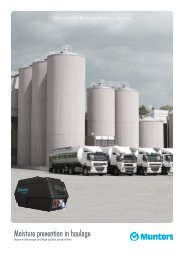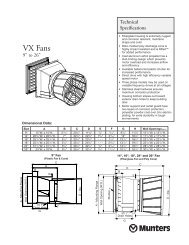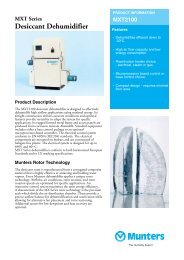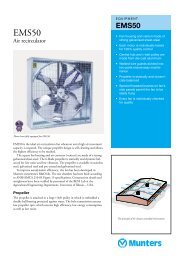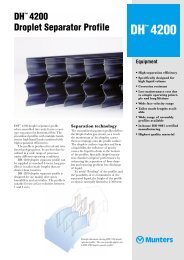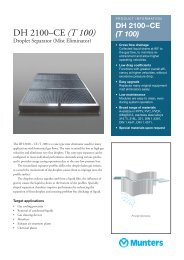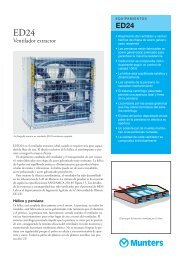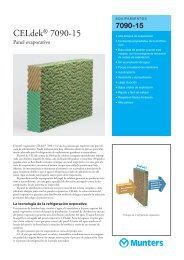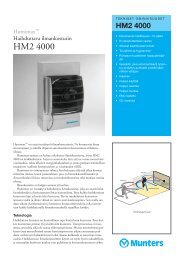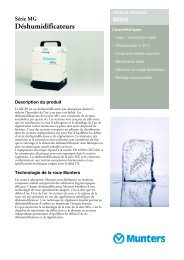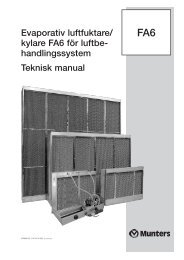Annual report 2008 - Munters
Annual report 2008 - Munters
Annual report 2008 - Munters
Create successful ePaper yourself
Turn your PDF publications into a flip-book with our unique Google optimized e-Paper software.
Moisture Control Services (MCS) division<br />
29<br />
They require a comprehensive range of services that smaller<br />
local damage restoration companies can seldom offer.<br />
This has had the result that an increasing proportion of<br />
business is based on national, and in some cases international,<br />
framework agreements that have been negotiated centrally<br />
and at fixed prices. The trend towards framework agreements<br />
has progressed the furthest in the UK and has been introduced<br />
in several markets in recent years. This trend favors<br />
<strong>Munters</strong>, since MCS is one of the few damage restoration<br />
companies working with a global organizational structure.<br />
With a well-developed system for key account management,<br />
<strong>Munters</strong> can take advantage of this trend. <strong>Munters</strong> estimates<br />
that framework agreements over time will account for about<br />
45 percent of sales within MCS, compared with 40 percent<br />
during <strong>2008</strong>. During the year, some ten new framework<br />
agreements were signed in Europe, the US and Australia.<br />
MCS has a large part of its operations in Europe, where<br />
the Nordic market accounts for a significant portion of sales.<br />
Today the division has considerable growth potential in the<br />
US and above all the Asian market and is well-prepared to<br />
increase its presence in these regions. <strong>Munters</strong>’ ambition is<br />
to grow in the US with a broader service offering. Expansion<br />
will take place primarily organically, but over time, selective<br />
acquisitions are possible.<br />
Mobile IT for rapid and efficient damage restoration<br />
Assignments within MCS are numerous, while the value of<br />
each assignment is usually relatively small. This creates opportunities<br />
for economies of scale and rationalization. The MCS<br />
division’s ambition is to greatly simplify and improve daily<br />
communication both internally between damage technicians<br />
and administrators, but also externally with customers in<br />
insurance cases. In addition to reducing the time devoted to<br />
administration of various projects for such tasks as filling in<br />
forms, damage <strong>report</strong>s and action plans, more efficient work<br />
methods can reduce the number of visits to damage sites and<br />
create clearer documentation. As a result, a mobile IT system<br />
called Field.Link was launched in large parts of the organization<br />
during <strong>2008</strong>. Experience from the UK market where<br />
the system has been in use for four years shows substantial<br />
potential for reducing costs while improving customer services,<br />
primarily through clearer online information flows and more<br />
rapid processing and service to key customers.<br />
Another prioritized area within MCS is work with key<br />
account management. This means consolidating contacts with<br />
the leading insurance companies through systematic work<br />
processes and clear information flows that make it easier for<br />
both <strong>Munters</strong> and the customer to follow project progress.<br />
Development during the year<br />
Organic growth during <strong>2008</strong> continued to show a positive<br />
trend, and MCS won additional market shares. The aftermath<br />
of hurricane Ike resulted in the most extensive restoration<br />
effort in the US since hurricane Katrina in 2005.<br />
Flooding in Iowa in the summer of <strong>2008</strong><br />
After several days of heavy rain in June <strong>2008</strong>, the situation<br />
was critical in the eastern and southeastern parts of<br />
the state of Iowa in the US. The many rivers that branch<br />
here and cover large parts of the state threatened to<br />
overflow. Just 15 years earlier, a large flood had caused<br />
tremendous damage, and when the flood dams on the<br />
Cedar River gave way on June 12, catastrophe was<br />
once again upon them. While Iowa City did not suffer as<br />
severely as was feared, the destruction in Cedar Rapids<br />
was very extensive. At one point, virtually the entire city<br />
center comprising more than 1,000 blocks was under<br />
water, and extensive property damage was <strong>report</strong>ed.<br />
President George W. Bush arrived at the disaster area<br />
with Air Force One on June 20 to inspect the damage<br />
with his own eyes. In addition to evacuation of more than<br />
20,000 Cedar Rapids residents by the authorities, flooding<br />
in the area was estimated to have caused damage<br />
for several billion dollars.<br />
<strong>Munters</strong>’ service technicians participated in the<br />
clean-up from the start and were responsible for 44<br />
major restoration projects, including police stations, fire<br />
stations, libraries and other large public buildings over<br />
the entire disaster area. As is often the case in this type<br />
of disaster work, employees in some cases worked for<br />
weeks on end, and the strain on the entire organization<br />
was substantial. All assignments were completed in a<br />
commendable manner, and the <strong>Munters</strong> employees<br />
who took part in the work have every reason to feel<br />
proud of their efforts.<br />
<strong>Munters</strong> <strong>Annual</strong> Report <strong>2008</strong>



